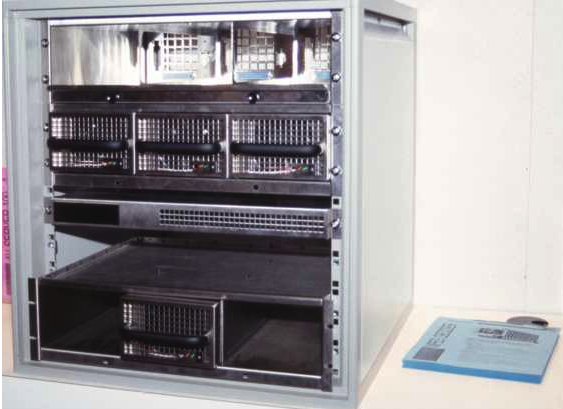History (1994): Micropolis: “Show Must Go On”
One of first manufacturers to develop special HDDs for audio and video
By Jean Jacques Maleval | November 30, 2020 at 2:12 pm“The show must go on,” said David Guo, video systems division manager at Micropolis Corp. (Chatsworth, CA), one of the first manufacturers to develop special HDDs for audio and video applications.
The real-time of audio and video recording requires drives to sustain a predetermined minimum data rate to avoid any jumps, gaps, and stutters in motion and sound. Thermal calibration techniques used in most standard drives to compensate the dilatations and contractions the components have to support on account of temperature changes cause transmission delays.(1)
Last year, Micropolis launched its first AV drives, with a technology named ATC (Advanced Thermal Calibration) that ensures the ‘worst case’ data access to always be less than 30ms.
The first products were the full-height 3.5-inch 2210 AV and 2217 AV with capacities of 1.06 and 1.76GB respectively, spinning at 5,400 rpm.
The firm’s new video systems division more recently announced the Taurus Model 4110 AV, a low-profile 3.5-inch 1GB unit (8.5ms, 5,400rpm, £895 suggested list price). It is based on the Taurus 4110 (£795) with volume shipments that started in April.
The Californian company has launched, at the recent NAB show, three new products for audio-video professionals: a video-on-demand server, a RAID subsystem for this market, and a MPEG video decoder.

The new AV server Series 100 stores movies on an array of AV drives in the MPEG data compression format. For example, the model 100-32/63 supports up to 32 NTSC or PAL video/audio streams which may be randomly selected by up to 32 viewers from 20 different movies. It stores 63GB and is housed in a 19-inch rack approximately 1.75 meters in height. It contains an array of seven 9.1GB 5.25-inch 1991 AV disk drives. The Raidion VOD Series 101 is capable of sustaining up to 64 randomly accessible data streams (viewers) at 3Mb/s per stream, making a fault-tolerant storage subsystem for small to medium video-on demand servers. At the heart of the product is a 33MHz RISC-based processor and parity ASIC that ensures not a single frame of video or millisecond of audio is missed even if a drive in the array fails. It features one or 2 Fast/Wide SCSI host bus interfaces on the host side and 4 Narrow/Fast SCSI bus interfaces on the drive side. They support up to 28 Micropolis AV 3.5 or 5.25-inch drives.
More surprising is the announcement by Micropolis of a new MPEG video decoder product. The multi-channel decoder series 102 is a Fast SCSI-2 based standalone adapter card which contains 4 MPEG-1 or MPEG-2 decoder modules. It is designed to provide 4 composite NTSC or PAL video and monophonic or stereo 44.1kHs audio outputs. This decoder is a key building block of the Micropolis Video Decoder Array (VDA) subsystem. The board measures 12x10x15 inches and is protected by a 19-inch rack steel casing including cooling fan and power supply, and feat u res a SCSI backplane connecting up to 8 decoder modules.
We will end with 2 other announcements from Micropolis that are more in the line of its standard products.
- The manufacturer announced that its Raidion LT and LS line 3.5-inch and 5.25-inch disk arrays now support the IBM SCSI host adapter, making the subsystem available to PS/2 Micro Channel SCSI board users. List price for the Raidion LT is £5,325 for a 3 module 3.5GB. The 3-module 5.25-inch based Raidion LS is priced at £6,403 for 4.2GB to £8,510 for a three-module 6.06GB unit. Both lines will also support the new Adaptec 274X family of EISA SCSI host adapters.
- The company enhances IDE line with the Taurus 4110A, a low profile 1GB, 3.5-inch disk drive. The new device has a 8.25W power consumption, which is a 33% reduction over previous models. The Taurus 4110A is available since April for evaluation with volume production in May. Suggested list price is £850 in single unit quantities. The manufacturer plans to launch this year a model Capricome with 4GB in a half height 3.5-inch form factor.
Additionally, it will launch on 3Q94 a 5.25-inch HDD with a capacity of about 18GB using the same design as the 9GB 1900 series, the same number of platters, but with MR heads.
(1) Quantum eliminated the need of thermal calibration so it doesn’t have this problem. Its actual units use the encapsulated servomotor technology that can restore large amounts of data without interruption. Here, the servomotor data, for a correct head positioning, is distributed on the entire HDD drive and entwined with the user’s data.

This article is an abstract of news published on the former paper version of Computer Data Storage Newsletter on issue 75, published on April 1994.













 Subscribe to our free daily newsletter
Subscribe to our free daily newsletter

